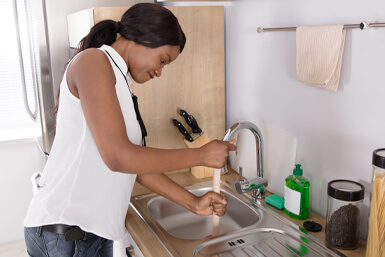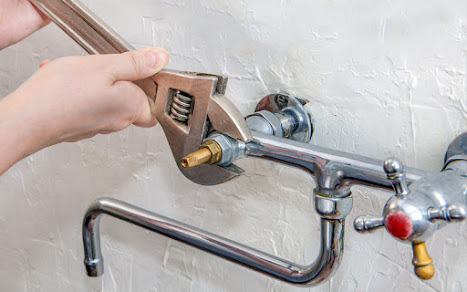Calling in the Pros: Common Appliance Problems Best Left to Plumbers
ViewJust about everyone will have their own unique conception when it comes to Why Your Water Pipes Are Noisy and How To Shut Them Up.

To detect loud plumbing, it is important to figure out initial whether the undesirable sounds happen on the system's inlet side-in various other words, when water is transformed on-or on the drainpipe side. Noises on the inlet side have varied reasons: too much water stress, worn valve as well as tap components, poorly connected pumps or other home appliances, improperly put pipeline bolts, and also plumbing runs containing way too many tight bends or other constraints. Noises on the drainpipe side usually come from bad area or, as with some inlet side noise, a format containing limited bends.
Hissing
Hissing sound that occurs when a tap is opened a little generally signals excessive water stress. Consult your neighborhood water company if you think this trouble; it will certainly be able to inform you the water stress in your area and can set up a pressurereducing shutoff on the incoming supply of water pipeline if essential.
Thudding
Thudding noise, typically accompanied by shivering pipelines, when a tap or appliance valve is turned off is a problem called water hammer. The sound and also vibration are caused by the resounding wave of stress in the water, which instantly has no place to go. In some cases opening a valve that discharges water swiftly right into an area of piping having a restriction, elbow, or tee fitting can create the exact same problem.
Water hammer can normally be healed by mounting fittings called air chambers or shock absorbers in the plumbing to which the problem valves or faucets are linked. These gadgets enable the shock wave developed by the halted circulation of water to dissipate airborne they have, which (unlike water) is compressible.
Older plumbing systems may have short vertical sections of capped pipe behind walls on faucet runs for the same purpose; these can eventually fill with water, decreasing or ruining their efficiency. The cure is to drain the water system completely by shutting off the main water supply valve and opening all faucets. After that open up the major supply shutoff and also shut the taps one by one, starting with the faucet nearest the shutoff and also finishing with the one farthest away.
Babbling or Shrieking
Intense chattering or screeching that occurs when a valve or tap is activated, which normally vanishes when the installation is opened completely, signals loose or defective internal components. The option is to replace the valve or faucet with a brand-new one.
Pumps and also home appliances such as washing devices and dishwashers can move electric motor noise to pipes if they are poorly attached. Connect such items to plumbing with plastic or rubber hoses-never rigid pipe-to isolate them.
Various Other Inlet Side Noises
Squeaking, squealing, scratching, snapping, and also touching typically are caused by the development or tightening of pipes, generally copper ones providing hot water. The sounds take place as the pipelines slide against loosened bolts or strike nearby house framework. You can typically pinpoint the area of the issue if the pipes are revealed; simply follow the audio when the pipes are making noise. More than likely you will discover a loosened pipe wall mount or an area where pipes exist so close to flooring joists or various other framing pieces that they clatter versus them. Connecting foam pipe insulation around the pipelines at the point of contact need to fix the problem. Make certain straps and also hangers are safe and secure as well as provide appropriate support. Where feasible, pipe bolts ought to be affixed to enormous structural aspects such as foundation wall surfaces instead of to mounting; doing so lessens the transmission of vibrations from plumbing to surface areas that can enhance and also transfer them. If connecting bolts to framing is inescapable, cover pipes with insulation or various other resilient product where they get in touch with fasteners, as well as sandwich the ends of brand-new bolts between rubber washing machines when installing them.
Remedying plumbing runs that suffer from flow-restricting limited or various bends is a last resource that ought to be undertaken just after consulting a proficient plumbing professional. However, this situation is relatively common in older homes that might not have been constructed with indoor plumbing or that have actually seen several remodels, particularly by amateurs.
Drainpipe Noise
On the drain side of plumbing, the chief objectives are to remove surface areas that can be struck by dropping or hurrying water and to insulate pipes to include inevitable noises.
In new building and construction, bath tubs, shower stalls, commodes, and also wallmounted sinks as well as containers must be set on or against durable underlayments to decrease the transmission of sound through them. Water-saving bathrooms as well as faucets are less loud than traditional designs; install them as opposed to older kinds even if codes in your area still allow making use of older fixtures.
Drainpipes that do not run up and down to the cellar or that branch into straight pipeline runs supported at flooring joists or various other framing existing specifically problematic noise troubles. Such pipelines are large sufficient to emit considerable resonance; they also lug considerable amounts of water, that makes the circumstance worse. In brand-new construction, define cast-iron dirt pipes (the huge pipes that drain pipes bathrooms) if you can afford them. Their enormity includes a lot of the noise made by water passing through them. Additionally, avoid transmitting drainpipes in wall surfaces shown bedrooms as well as rooms where individuals gather. Wall surfaces including drains ought to be soundproofed as was defined earlier, making use of double panels of sound-insulating fiber board as well as wallboard. Pipes themselves can be covered with special fiberglass insulation made for the function; such pipes have a resistant vinyl skin (sometimes consisting of lead). Results are not always satisfactory.
WHY IS MY PLUMBING MAKING SO MUCH NOISE?
This noise indeed sounds like someone is banging a hammer against your pipes! It happens when a faucet is opened, allowed to run for a bit, then quickly shut — causing the rushing water to slam against the shut-off valve.
To remedy this, you’ll need to check and refill your air chamber. Air chambers are filled with — you guessed it — air and help absorb the shock of moving water (that comes to a sudden stop). Over time, these chambers can fill with water, making them less effective.
You’ll want to turn off your home’s water supply, then open ALL faucets (from the bathroom sink to outdoor hose bib) to drain your pipes. Then, turn the water back on and hopefully the noise stops! If you’re still hearing the sound, give us a call to examine further.
Whistles
Whistling sounds can be frustrating, as sometimes the source isn’t easily identified. However, if you can pinpoint which faucet or valve that may be the cause, you’ll likely encounter a worn gasket or washer — an easy fix if you replace the worn parts!Whistling sounds from elsewhere can mean a number of things — from high water pressure to mineral deposits. Your best plan of attack here is to give our plumbing experts a call. We’ll be able to determine where the noise is coming from and what the cause may be, then recommend an effective fix!
Cracks or Ticks
Cracking or ticking typically comes from hot water going through cold, copper pipes. This causes the copper to expand resulting in a cracking or ticking sound. Once the pipes stop expanding, the noise should stop as well.
Pro tip: you may want to lower the temperature of your water heater to see if that helps lessen the sound, or wrapping the pipe in insulation can also help muffle the noise.
Bangs
Bangs typically come from water pressure that’s too high. To test for high water pressure, get a pressure gauge and attach it to your faucet. Water pressure should be no higher than 80 psi (pounds per square inch) and also no lower than 40 psi. If you find a number greater than 80 psi, then you’ve found your problem!
Next step is to give us a call in order to install a pressure regulator. Trust us, you don’t want to wait to resolve this issue. Not only is the sound annoying, but high water pressure can be destructive to your home — including damaging certain appliances, like your washer and dishwasher.
Dripping
You might be accustom to the slow quiet drip your kitchen faucet makes. You might have even tuned out your bathroom sink dripping and drabbing all day long — but it’s time to find its cause.
A slow drip could signify a variety of easy to fix issues, such as a worn out O ring, or loose part. And by ignoring the drip, you could be wasting up to 2,000 gallons of water a year! So start conserving water — get it looked at ASAP.
https://www.pwessig.com/blog/2018/december/why-is-my-plumbing-making-so-much-noise-/

Do you appreciate reading up on Why Your Water Pipes Are Noisy and How To Shut Them Up? Create feedback further down. We would be delighted to listen to your ideas about this article. We are looking forward to see you back again in the near future. You should take the opportunity to share this blog if you enjoyed reading it. I recognize the value of reading our article about Why is My Home Making Strange Plumbing Noises.
Information